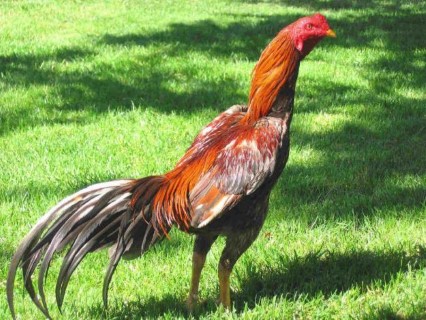Aseel, or
Asil, chickens originated from the South Punjab / Sindh area of Pakistan and
India. They are found throughout Southeast Asia, such as Shamo and Thai Game. They
are generally unstandardized in South Asia and India, but popularity has
increased in the western world in recent times with the breed standardized in
the British, Australian, and American standards.
Aseel Chickens
mature slowly but develop into stocky fowl. With a stout constitution, natural
intelligence, and enduring physiology they survive well in free-range
conditions. Aseel’s are broody and some farmers use them to hatch eggs for less
broody breeds. They bear confinement well as long as that confinement also
includes same sex isolation. Aseel hens lay only one egg a week--a fact which
has led to their steady decline. Their beautiful plumage, value as foundation
stock, and use as fighting cocks has saved this breed from slipping into
extinction.
Ancient Aseel
ranks as one of the fiercest game hens in the world. They will fight for days
without end and will fight to the death. Hens fight hens. Roosters fight
roosters. Even chicks fight chicks. However, Aseel hens treat their brood with
unusual tenderness and will protect them from snakes or vermin. Aseel owners
have even seen Aseel roosters protecting the young. Surprisingly, though
vicious with each other, Aseels prove quite docile in the presence of humans.
Formidable
fighters, the Aseel has a compact frame, large bones, broad shoulders, muscular
hips, and sharp spurs. They carry themselves in an upright stance as if just
looking for a fight. Pale, pearl colored eyes stare at their opponents from
under a heavy brow reminiscent of birds of prey. Aseel's small pea comb,
wattles, and short glossy feathers leave little for an opponent to grab or
tear. From their broad skull to their one-of-kind, horizontal fanning tail, the
Aseel has few if any who can contend with him outside of his own kind.
Aseels do well
in free-range conditions but will tolerate confinement if needed. Keep the
number of Aseels in your flock low. Limit the number of roosters to those
necessary for reproduction. Keep roosters apart at all times. Make sure the
hens have plenty of room in the coop to roost and stay out of each other's way.
Aseels can tolerate some cold; however, they need to stay dry. Roosters will
fly and even dig to get to another rooster for a fight. Make sure you make the
roosters coop secure from both escape and invasion. Only the experienced
poultry person should attempt keeping an Aseel flock.

